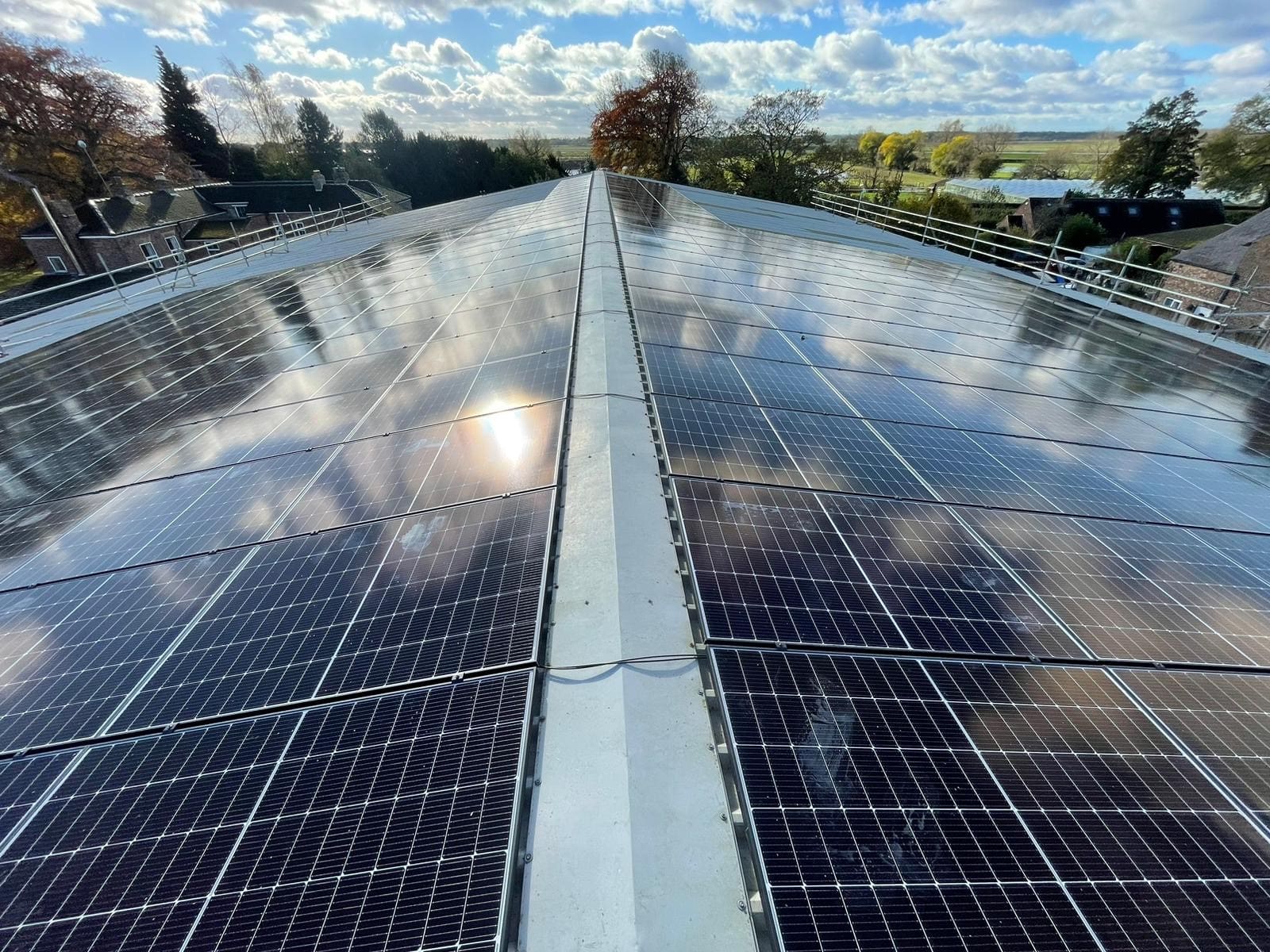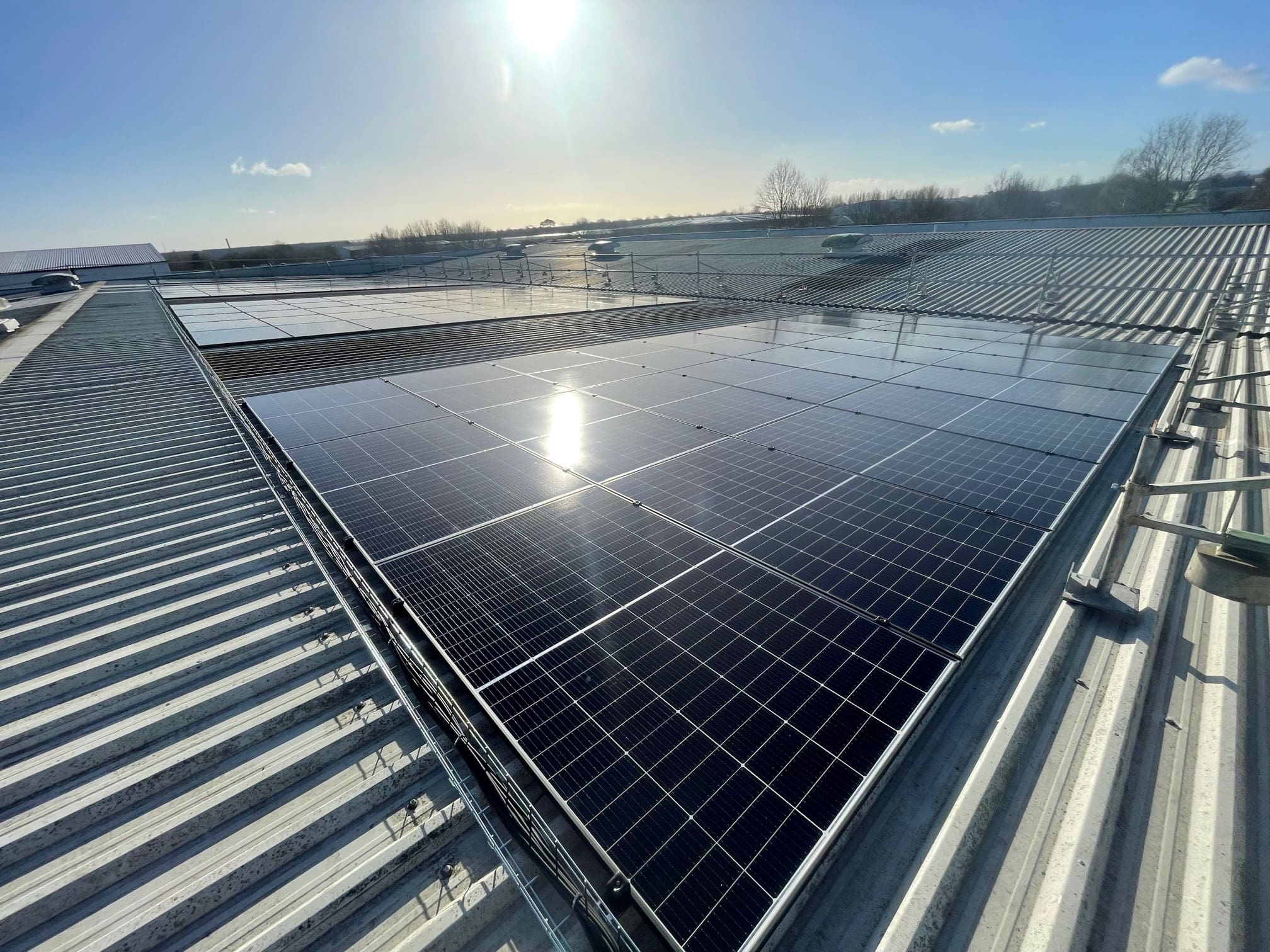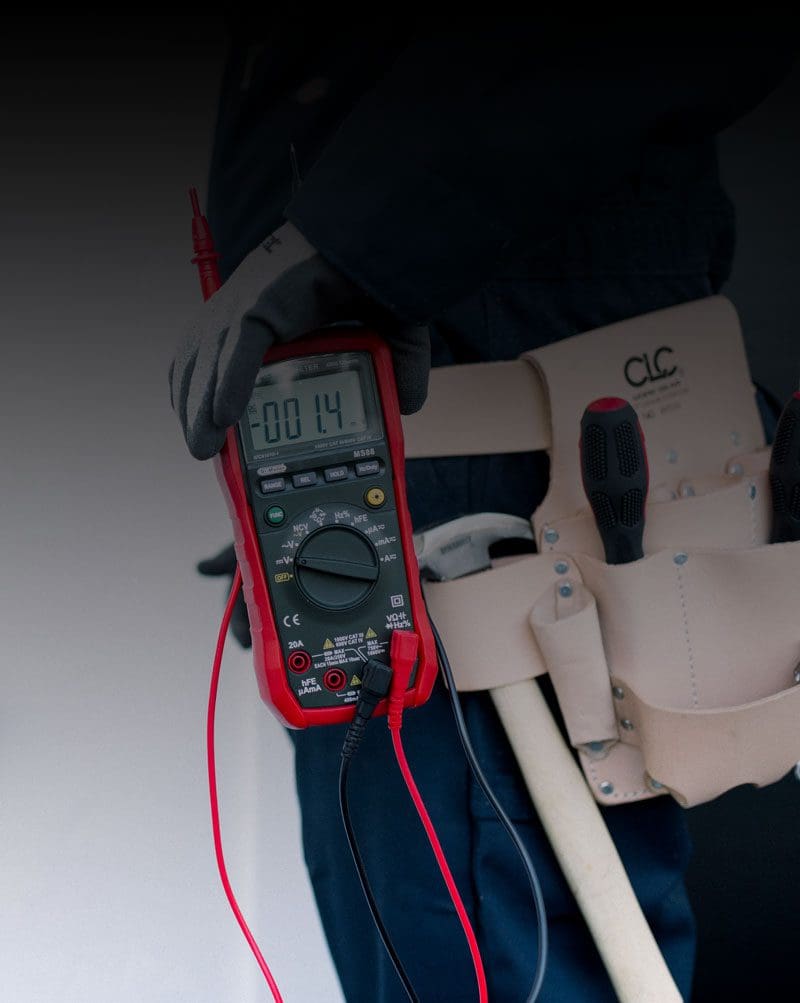Powering Up Your Business:
A Comprehensive Guide to UK Commercial Solar Panel Yield.
Investing in a roof-mounted commercial solar panel system in the UK offers businesses a tangible path to reduced energy costs, a smaller carbon footprint, and enhanced energy independence. However, understanding the potential annual electrical power yield is crucial for making an informed decision. This article details the default calculations used to establish this yield, factoring in essential variables, and provides practical examples for various business types.
Decoding Solar Panel Yield: The Core Calculation
The annual electrical power yield of a solar panel system is typically measured in kilowatt-hours (kWh) per year. This represents the total amount of usable electricity your panels are estimated to generate over a 12-month period. While highly accurate calculations involve sophisticated software used by installers (like MCS Installers Standard Estimation Method or PV GIS), a robust default calculation can provide a strong initial estimate.
The most common and effective rule of thumb for calculating annual solar energy output in the UK is:
Annual Solar Panel Energy Output (kWh) = System size (kWp) x kK factor x Shading Factor (SF)
Let’s break down each component:
- System Size (kWp – Kilowatt-peak): This refers to the maximum power output of your solar panel array under ideal laboratory conditions. It’s determined by the sum of the peak power ratings of all individual panels in your system. For example, 10 solar panels each with a peak output of 400 Wp would constitute a 4 kWp system (10 x 400 Wp = 4000 Wp = 4 kWp). The available roof space will often dictate the maximum system size you can install.
- kK Factor (Kilowatt-hour per Kilowatt-peak): This crucial factor accounts for the real-world performance of solar panels in the UK, considering:
- Location in the UK (Area of the Country): Solar irradiance (sunlight intensity) varies across the UK. Southern regions, such as the South West of England, receive more sunshine hours annually compared to northern areas like Scotland. This means a system in Cornwall will generally yield more power than an identical system in the Shetland Islands. Installers use postcode-specific data to determine a precise kK value, but a general UK average is often around 950 kWh/kWp per year.
- Roof Orientation (Azimuth): The angle of the panels from true south. A south-facing roof is generally considered optimal for maximum energy generation in the Northern Hemisphere. Systems facing south-east or south-west might see a slight reduction (e.g., 95% of a south-facing yield), while east or west-facing systems could experience a more significant drop (e.g., 80%).
- Roof Pitch (Angle from Horizontal): The tilt of the panels. In the UK, an optimal pitch for solar panels is typically around 35 degrees. Variations from this angle will impact performance, with steeper or shallower pitches leading to slightly lower yields.
- Shading Factor (SF): This accounts for any obstructions that might shade your solar panels throughout the day or year. Trees, chimneys, adjacent buildings, or even dirt and debris on the panels can reduce their efficiency. A thorough site assessment by an installer will use shading analysis tools to determine this factor. A perfectly unshaded system would have an SF of 1.0 (or 100%), while partial shading would result in a lower decimal value (e.g., 0.9 for 90% efficiency due to shading).
Daylight Hours in the UK: A Variable but Essential Factor
While the kK factor implicitly incorporates average sunlight levels and seasonal variations, it’s worth understanding the role of daylight hours. The UK experiences significant seasonal fluctuations in daylight, with long summer days offering maximum generation potential and short winter days yielding less.
- Summer: Longer daylight hours and a higher sun angle lead to peak energy generation. Businesses may even generate surplus energy during these months, which can be stored in batteries or exported to the grid.
- Winter: Shorter daylight hours, lower sun angles, and increased cloud cover result in reduced energy production. However, modern PV technology is designed to harness energy even in low-light conditions, ensuring continued, albeit lower, output.
The kK factor, derived from extensive meteorological data, already averages these seasonal variations, providing an annualised estimate.
Translating to Workable Calculations: A Practical Table
To help businesses considering solar investment, here’s how these factors translate into practical calculations. Please note that these are general guides; a professional installer will provide a precise, site-specific estimate.
|
Factor Category |
Specific Factor |
Typical UK Default Value / Range |
Impact on Calculation |
|
System Size |
Number of panels |
Varies based on roof space (e.g., 20-100+ panels for commercial) |
Directly proportional to kWp; more panels usually mean more output. |
|
Individual panel wattage |
350-450 Wp (commercial panels) |
Higher wattage per panel increases system kWp. |
|
|
Site Specifics (kK Factor) |
UK Location (Solar Irradiance) |
General average: 950 kWh/kWp/year |
Higher in Southern UK (e.g., Land’s End: ~1091 kWh/kWp), lower in Northern UK (e.g., Edinburgh: ~902 kWh/kWp). |
|
Roof Orientation |
South-facing: 100% (of kK factor) |
SE/SW: ~95% of south-facing output; E/W: ~80% of south-facing output. |
|
|
Roof Pitch |
Optimal: 35 degrees |
Deviations from optimal angle reduce efficiency. |
|
|
External Influences |
Shading Factor (SF) |
0.75 – 1.0 (75% – 100%) |
1.0 for no shading, lower for partial shading. Crucial for accurate yield. |
|
Panel Degradation |
~0.5% – 1% per year |
Accounted for in long-term projections by installers; initial calculations assume new panel performance. |
|
|
Temperature |
UK climate is generally optimal |
Extremely high temperatures can slightly reduce efficiency, but typically less of an issue in the UK. |
|
|
Dirt & Debris |
Minor, but regular cleaning recommended |
Can reduce output if significant accumulation occurs. |
Example Calculation Formula Breakdown:
Let’s assume a business in the Midlands (e.g., Birmingham area) with:
- A 30 kWp solar panel system (e.g., 75 x 400 Wp panels)
- A south-facing roof at an optimal pitch (kK factor for Midlands: ~935 kWh/kWp)
- Minimal shading (Shading Factor: 0.95)
Annual Estimated Yield = 30 kWp x 935 kWh/kWp x 0.95 = 26,647.5 kWh per year
What Percentage of Annual Electrical Use Might Solar Offer?
The percentage of annual electrical use that solar generated power can offset depends heavily on a business’s overall energy consumption and the size of the installed solar system. Here are some guide examples for different types of UK businesses:
-
- Small Office Premises (e.g., 5-20 employees):
- Annual Electricity Use: 5,000 – 15,000 kWh (Micro to Small Business size)
- Potential Solar System Size: 5-15 kWp (often limited by roof space)
- Estimated Solar Yield (Mid-UK, optimal): 4,750 – 14,250 kWh/year
- Potential Offset: 30% – 90% or more, depending on system size and base consumption. Smaller offices with larger solar systems can often become almost entirely self-sufficient in electricity during daylight hours.
- Small Manufacturers (e.g., light engineering, workshops):
- Annual Electricity Use: 15,000 – 50,000 kWh (Small to Medium Business size)
- Potential Solar System Size: 20-50 kWp (good roof space typically available)
- Estimated Solar Yield (Mid-UK, optimal): 19,000 – 47,500 kWh/year
- Potential Offset: 40% – 80%, as manufacturing processes often have higher base loads, but a substantial portion can be covered. Daytime operations are particularly suited to solar.
- Warehouses/Logistics Centres:
- Annual Electricity Use: 50,000+ kWh (Medium to Large Business size, often significantly higher)
- Potential Solar System Size: 50 kWp – 250+ kWp (large, often flat, roof spaces)
- Estimated Solar Yield (Mid-UK, optimal): 47,500 – 237,500+ kWh/year
- Potential Offset: 20% – 60%. While warehouses have large electricity demands (especially for lighting and automated systems), their expansive roof areas make them ideal candidates for very large solar arrays, leading to significant absolute energy savings even if the percentage offset is lower than a small office.
- Retail Stores:
- Annual Electricity Use: Varies widely (e.g., small boutique to large supermarket) – 10,000 kWh to 100,000+ kWh
- Potential Solar System Size: 10-100 kWp
- Estimated Solar Yield (Mid-UK, optimal): 9,500 – 95,000 kWh/year
- Potential Offset: 30% – 70%. Stores with long daytime operating hours can significantly benefit from solar power.
- Small Office Premises (e.g., 5-20 employees):
Beyond the Numbers: Key Considerations for Businesses
While the calculations provide a strong foundation, businesses should also consider:
-
- Energy Storage (Batteries): For businesses looking to maximize self-consumption and reduce reliance on the grid outside of solar generation hours, battery storage can be a valuable addition.
- Export Tariffs: Any excess electricity generated can often be sold back to the national grid through various export tariffs, providing an additional revenue stream.
- Government Incentives: While feed-in tariffs have ended, other schemes and grants may be available to support commercial solar installations.
- Maintenance: Solar panels require minimal maintenance, primarily occasional cleaning to ensure optimal performance.
- Professional Assessment: Always engage a reputable MCS-certified solar installer. They will conduct a detailed site survey, perform precise calculations, and provide a tailored proposal, ensuring your system is optimally designed for your specific business needs and location.
Conclusion
By understanding these default calculations and the factors that influence them, UK businesses can gain a clearer picture of the substantial benefits that a roof-mounted commercial solar panel system can offer, paving the way for a more sustainable and cost-effective future.
Our Services
Commercial Solar Panels
We have designed and installed high yield commercial solar panel systems for many clients. We can provide all design and payback calculations and ongoing maintenance.
Agricultural Solar Panels
We have many years experience designing and installing agricultural solar panel systems for farm businesses and saving them huge costs on electrical energy.
Residential Solar Panels
Our design and solar panel installation engineers have over a decade of experience installing and maintaining solar PV systems for residential customers across the UK
Electrical Contractors
We are NICEIC registered electrical contractors and members of the Electrical Contractors Association for all industrial, commercial and residential electrical services including testing, inspection and compliance services.
Mechanical Services
We offer M&E design, calculation, estimation and full fit-out, installation and maintenance services to commercial clients. We also provide contract maintenance and building compliance and testing services
Solar Renewables
We are MCS and RECC registered solar panel installers for all commercial and residential solar panel installations including ground arrays and roof mounted PV systems and battery storage configurations.
EV Home Chargers
We fit all makes, models and types of EV Chargers for residential customers. We are Office for Zero Emission Vehicles (OZEV) authorised installers.
EV Workplace Chargers
We can undertake all required aspects of commercial EV charging point installation, from initial design and consultation to servicing and on-going maintenance.
Gas Boiler Engineers
We are Gas Safe Registered and undertake boiler installation, servicing and all gas safety checks for landlords and residential customers.
Solar Panel Installer
Photovoltaic Systems generate no greenhouse gases, a typical domestic system can save approximately 1.2 tonnes of carbon dioxide emissions per year – adding up to almost 30 tonnes over a system’s lifetime.
Our design and solar panel installation engineers have many years experience installing solar PV systems for industrial and commercial clients.
Contact Us
Solar Panel Enquiry
Address
Keighley, West Yorkshire
BD21 4PF
UK
What3Words
What3Words:///clocks.decide.pokers
Phone
Keighley: 01535 687010 Skipton: 01756 793039




